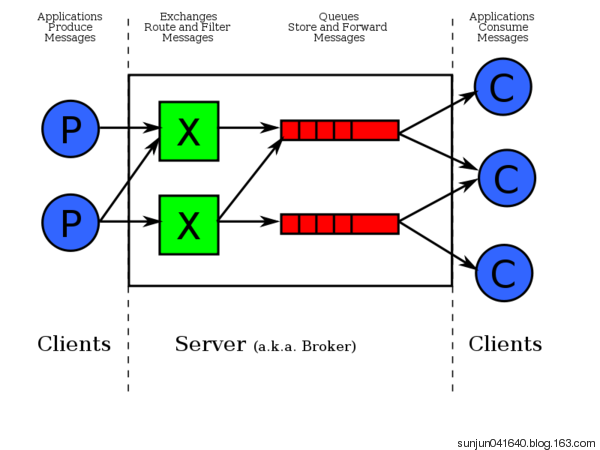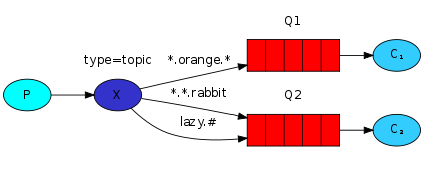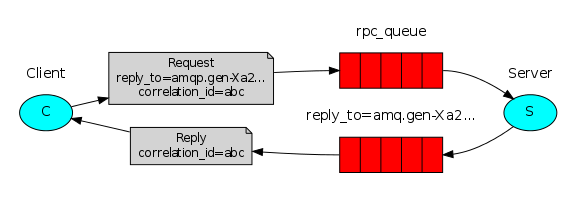安装python rabbitMQ module
pip install pika 官网 https://pypi.python.org/pypi/pika
安装rabbit-server服务,centos7系统
这个中间商就是MQ erlang语言支持的 安装依赖ERLANG wget https://mirrors.tuna.tsinghua.edu.cn/epel/7/x86_64/Packages/e/epel-release-7-11.noarch.rpm rpm -ivh epel-release-7-11.noarch.rpm yum repolist yum clean all yum install erlang 安装依赖SOCAT yum - y install socat 安装RABBITMQ rpm - ivh https: // bintray.com / rabbitmq / rabbitmq - server - rpm / download_file?file_path = rabbitmq - server - 3.6.10 - 1.el7.noarch.rpm /sbin/service rabbitmq - server start 端口号 5672
简单队列通信

远程连接rabbit server的话,需要配置远程用户,权限
在rabbitmq server上创建用户
rabbitmqctl add_user joker 123456
配置权限,允许从外面访问
rabbitmqctl set_permissions -p "/" joker '.*' '.*' '.*'
set_permissions [-p vhost] {user} {conf} {write} {read}
vhost
The name of the virtual host to which to grant the user access, defaulting to /.
user
The name of the user to grant access to the specified virtual host.
conf
A regular expression matching resource names for which the user is granted configure permissions.
write
A regular expression matching resource names for which the user is granted write permissions.
read
A regular expression matching resource names for which the user is granted read permissions.
消息队列收发端连接到远程的rabbit-server需要配置认证参数
credentials = pika.PlainCredentials('joker', 'joker123')
connection = pika.BlockingConnection(pika.ConnectionParameters(
'remoteip',5672,'/',credentials))
channel = connection.channel()
send端
import pika
connection = pika.BlockingConnection(pika.ConnectionParameters(
'localhost')) # 建立socket
channel = connection.channel() # 建立通道
#声明queue
channel.queue_declare(queue='hello') # 通道里面声明队列
#n RabbitMQ a message can never be sent directly to the queue, it always needs to go through an exchange.
channel.basic_publish(exchange='',
routing_key='hello', # 队列
body='Hello World!') # 消息
print(" [x] Sent 'Hello World!'")
connection.close()
receive端
import pika
connection = pika.BlockingConnection(pika.ConnectionParameters(
'localhost'))
channel = connection.channel()
#You may ask why we declare the queue again ‒ we have already declared it in our previous code.
# We could avoid that if we were sure that the queue already exists. For example if send.py program
#was run before. But we're not yet sure which program to run first. In such cases it's a good
# practice to repeat declaring the queue in both programs.
channel.queue_declare(queue='hello')
def callback(ch, method, properties, body):
print(" [x] Received %r" % body)
channel.basic_consume(callback,
queue='hello',
no_ack=True) # 这个是不需要接收确认信息,后面会继续说
print(' [*] Waiting for messages. To exit press CTRL+C')
channel.start_consuming() # 开始接收消息,这里是阻塞状态,一直接收下去
Work Queues

这种模式下,RabbitMQ会默认把p发的消息依次分发给各个消费者(c),跟负载均衡差不多
采用轮训机制,如果有多个消费者,会按照先后顺序发送消息
消费者处理完了告诉生产者处理完了,生产者就会从消息队列删除消息,如果没有处理完宕机了,那消息就没了
no_ack=FALSE
# 当消费者执行任务的时候断掉,那么这个消息就掉了,no_ack注销掉,消费者就必须给服务器信息,是否执行完了,手动给服务器确认
# 判断断掉的机制就是SOCKET断了
ch.basic_ack(delivery_tag=method.delivery_tag) # 手动跟服务端确认
消息持久化
channel.queue_declare(queue='hello', durable=True) # 持久化消息队列名称
channel.basic_publish(exchange='',
routing_key="task_queue",
body=message,
properties=pika.BasicProperties(
delivery_mode = 2, # make message persistent # 消息持久化
))
服务器宕机,队列里的消息持久在
消息公平发布
消息公平分发,谁有本事(性能高)你多发,看队列有多少消息channel.basic_qos(prefetch_count=1),我这里有一条消息就先别给我发

channel.basic_qos(prefetch_count=1)
生产者端
# !/usr/bin/env python
# _*_coding:utf-8_*_
# Author:Joker
import pika
username = 'joker'
pwd = '123456'
user_pwd = pika.PlainCredentials(username, pwd)
connection = pika.BlockingConnection(pika.ConnectionParameters(
host='remoteip',port=5672,credentials=user_pwd)) # 建立SOCKET
channel = connection.channel() # 建立通道
# 管道里面声明queue
channel.queue_declare(queue='hello2',durable=True) # 持久化队列
# n RabbitMQ a message can never be sent directly to the queue, it always needs to go through an exchange.
channel.basic_publish(exchange='',
routing_key='hello2', # QUEUE名字
body='Hello World!',
properties=pika.BasicProperties( # 消息持久化
delivery_mode=2, # make message persistent
)
) # 消息内容
print(" [x] Sent 'Hello World!'")
connection.close()
消费者端
# !/usr/bin/env python
# _*_coding:utf-8_*_
# Author:Joker
import pika,time
username = 'joker'
pwd = '123456'
user_pwd = pika.PlainCredentials(username, pwd)
connection = pika.BlockingConnection(pika.ConnectionParameters(
host='remoteip',port=5672,credentials=user_pwd))
channel = connection.channel()
# You may ask why we declare the queue again ‒ we have already declared it in our previous code.
# We could avoid that if we were sure that the queue already exists. For example if send.py program
# was run before. But we're not yet sure which program to run first. In such cases it's a good
# practice to repeat declaring the queue in both programs.
channel.queue_declare(queue='hello2',durable=True) # 无法保证生产消费谁先运行,为了不出错可以自己声明,durable=True持久化队列
def callback(ch, method, properties, body):
print(ch,method,properties)
# <BlockingChannel impl=<Channel number=1 OPEN conn=<SelectConnection OPEN socket=('192.168.0.139', 49993)->('60.205.188.107', 5672) params=<ConnectionParameters host=60.205.188.107 port=5672 virtual_host=/ ssl=False>>>>
# <Basic.Deliver(['consumer_tag=ctag1.e67a54d9b91a40ab82647f2dafa9d9ba', 'delivery_tag=2', 'exchange=', 'redelivered=False', 'routing_key=hello'])>
# <BasicProperties(['delivery_mode=2'])>
# 通道的内存对象,链接的消息,消息属性见下面
# time.sleep(30)
print(" [x] Received %r" % body)
ch.basic_ack(delivery_tag=method.delivery_tag) # 手动跟服务端确认,devlivery_tag是信息标签,一般是第一条是1,第二条是2
channel.basic_qos(prefetch_count=1) # 如果我这里还有消息就先别发给我
channel.basic_consume(# 消费消息
callback, # 如果收到消息,就调用CALLBACK函数来处理消息
queue='hello2', # 从哪个队列收消息
# no_ack=True) # 不会给服务端发消息,是否处理完
)
print(' [*] Waiting for messages. To exit press CTRL+C')
channel.start_consuming() # 永远收下去
Propertie
content_type : 消息内容的类型 content_encoding: 消息内容的编码格式 priority: 消息的优先级 correlation_id:关联id reply_to: 用于指定回复的队列的名称 expiration: 消息的失效时间 message_id: 消息id timestamp:消息的时间戳 type: 类型 user_id: 用户id app_id: 应用程序id cluster_id: 集群id
PublishSubscribe(消息发布订阅)
我们在之前学习的是1对1的消息发送接收,也就是消息只能发送到指定的queue,如果你想发送的消息让所有的queue收到,就要用到exchage了
Exchange在定义的时候有类型的,以决定到底是哪些queue符合条件,可以接收消息
fanout: 所有bind到此exchange的queue都可以接收消息
EXCHANGE FANDOUT 纯广播,因为广播的原因,不会帮你保留消息,消费者先启动才能收到消息,每个人都能收到
消息publisher
# !/usr/bin/env python
# _*_coding:utf-8_*_
# Author:Joker
import pika
import sys
username = 'joker'
pwd = '123456'
user_pwd = pika.PlainCredentials(username, pwd)
connection = pika.BlockingConnection(pika.ConnectionParameters(
host='remoteip',port=5672,credentials=user_pwd)) # 建立SOCKET
channel = connection.channel() # 建立通道
channel.exchange_declare(exchange='logs',exchange_type='fanout') # 广播不需要写Q
message = ' '.join(sys.argv[1:]) or "info: Hello World!"
channel.basic_publish(exchange='logs',
routing_key='', # Q 名
body=message)
print(" [x] Sent %r" % message)
connection.close()
消息subscriber
# !/usr/bin/env python
# _*_coding:utf-8_*_
# Author:Joker
import pika
username = 'joker'
pwd = '123456'
user_pwd = pika.PlainCredentials(username, pwd)
connection = pika.BlockingConnection(pika.ConnectionParameters(
host='remoteip',port=5672,credentials=user_pwd)) # 建立SOCKET
channel = connection.channel() # 建立通道
channel.exchange_declare(exchange='logs',exchange_type='fanout')
result = channel.queue_declare(exclusive=True) # 不指定queue名字,rabbit会随机分配一个名字,exclusive=True会在使用此queue的消费者断开后,自动将queue删除
queue_name = result.method.queue
print(queue_name) # 随机
channel.queue_bind(exchange='logs', # 绑定Q到转发器EXCHAGE上
queue=queue_name) #
print(' [*] Waiting for logs. To exit press CTRL+C')
def callback(ch, method, properties, body):
print(" [x] %r" % body)
channel.basic_consume(callback,
queue=queue_name,
no_ack=True)
channel.start_consuming()
有选择的接收消息exchage type=direct
队列绑定关键字,发送者将数据根据关键字发送到消息exchange,exchange根据 关键字 判定应该将数据发送至指定队列

publisher
# !/usr/bin/env python # _*_coding:utf-8_*_ # Author:Joker
import pika import sys username = 'joker' pwd = '123456' user_pwd = pika.PlainCredentials(username, pwd) connection = pika.BlockingConnection(pika.ConnectionParameters( host='remoteip',port=5672,credentials=user_pwd)) # 建立SOCKET channel = connection.channel() # 建立通道 channel.exchange_declare(exchange='direct_logs', exchange_type='direct') severity = sys.argv[1] if len(sys.argv) > 1 else 'info' message = ' '.join(sys.argv[2:]) or 'Hello World!' channel.basic_publish(exchange='direct_logs', routing_key=severity, body=message) print(" [x] Sent %r:%r" % (severity, message)) connection.close() # import sys # print(sys.argv[0]) # /Users/liqianlong/Desktop/Django project/kkk/开启py之旅/消息队列/7DIRECT_PUBLISHER.py
subscriber
# !/usr/bin/env python
# _*_coding:utf-8_*_
# Author:Joker
import pika
import sys
username = 'joker'
pwd = '123456'
user_pwd = pika.PlainCredentials(username, pwd)
connection = pika.BlockingConnection(pika.ConnectionParameters(
host='remoteip',port=5672,credentials=user_pwd)) # 建立SOCKET
channel = connection.channel() # 建立通道
channel.exchange_declare(exchange='direct_logs',
exchange_type='direct')
result = channel.queue_declare(exclusive=True)
queue_name = result.method.queue
severities = sys.argv[1:] # 获取脚本后面跟的参数,WARNING,ERROR,INFO ..
if not severities:
sys.stderr.write("Usage: %s [info] [warning] [error]
" % sys.argv[0])
sys.exit(1)
for severity in severities:
channel.queue_bind(exchange='direct_logs',
queue=queue_name,
routing_key=severity)
print(' [*] Waiting for logs. To exit press CTRL+C')
def callback(ch, method, properties, body):
print(" [x] %r:%r" % (method.routing_key, body))
channel.basic_consume(callback,
queue=queue_name,
no_ack=True)
channel.start_consuming()
更细致的消息过滤exchage type=topic

publisher
# !/usr/bin/env python
# _*_coding:utf-8_*_
# Author:Joker
import pika
import sys
username = 'joker'
pwd = '123456'
user_pwd = pika.PlainCredentials(username, pwd)
connection = pika.BlockingConnection(pika.ConnectionParameters(
host='remoteip',port=5672,credentials=user_pwd)) # 建立SOCKET
channel = connection.channel() # 建立通道
channel.exchange_declare(exchange='topic_logs',
exchange_type='topic')
routing_key = sys.argv[1] if len(sys.argv) > 1 else 'anonymous.info'
message = ' '.join(sys.argv[2:]) or 'Hello World!'
channel.basic_publish(exchange='topic_logs',
routing_key=routing_key,
body=message)
print(" [x] Sent %r:%r" % (routing_key, message))
connection.close()
subscriber
# !/usr/bin/env python
# _*_coding:utf-8_*_
# Author:Joker
import pika
import sys
username = 'joker'
pwd = '123456'
user_pwd = pika.PlainCredentials(username, pwd)
connection = pika.BlockingConnection(pika.ConnectionParameters(
host='remoteip',port=5672,credentials=user_pwd)) # 建立SOCKET
channel = connection.channel() # 建立通道
channel.exchange_declare(exchange='topic_logs',
exchange_type='topic')
result = channel.queue_declare(exclusive=True)
queue_name = result.method.queue
binding_keys = sys.argv[1:] # 监测的文件匹配
if not binding_keys:
sys.stderr.write("Usage: %s [binding_key]...
" % sys.argv[0])
sys.exit(1)
for binding_key in binding_keys:
channel.queue_bind(exchange='topic_logs',
queue=queue_name,
routing_key=binding_key)
print(' [*] Waiting for logs. To exit press CTRL+C')
def callback(ch, method, properties, body):
print(" [x] %r:%r" % (method.routing_key, body))
channel.basic_consume(callback,
queue=queue_name,
no_ack=True)
channel.start_consuming()
To receive all the logs run:
python receive_logs_topic.py "#" 可以收取所有的信息
To receive all logs from the facility "kern":
python receive_logs_topic.py "kern.*"
Or if you want to hear only about "critical" logs:
python receive_logs_topic.py "*.critical"
You can create multiple bindings:
python receive_logs_topic.py "kern.*" "*.critical"
And to emit a log with a routing key "kern.critical" type:
python emit_log_topic.py "kern.critical" "A critical kernel error"
Remote procedure call(RPC)
远程调用方法执行,SNMP简单网络管理协议,发一条执行返回结果就是一个简单的RPC,实现的就是服务器端也是客户端双向

server
#_*_coding:utf-8_*_
__author__ = 'joker lii'
import pika
import time
connection = pika.BlockingConnection(pika.ConnectionParameters(
host='localhost'))
channel = connection.channel()
channel.queue_declare(queue='rpc_queue')
def fib(n):
if n == 0:
return 0
elif n == 1:
return 1
else:
return fib(n-1) + fib(n-2)
def on_request(ch, method, props, body):
n = int(body)
print(" [.] fib(%s)" % n)
response = fib(n)
ch.basic_publish(exchange='', # 结果发挥给客户端
routing_key=props.reply_to, # props指的就是客户端里面的replay_to的q
properties=pika.BasicProperties(correlation_id =
props.correlation_id), # 客户端的correlation_id
body=str(response))
ch.basic_ack(delivery_tag = method.delivery_tag) # 确保消息消费了
channel.basic_qos(prefetch_count=1)
channel.basic_consume(on_request, queue='rpc_queue')
print(" [x] Awaiting RPC requests")
channel.start_consuming()
client
import pika import uuid
import time class FibonacciRpcClient(object): def __init__(self): self.connection = pika.BlockingConnection(pika.ConnectionParameters( host='localhost')) # socket self.channel = self.connection.channel() # 通道 result = self.channel.queue_declare(exclusive=True) self.callback_queue = result.method.queue # 随机q self.channel.basic_consume(self.on_response, no_ack=True, # on_response 回调函数 queue=self.callback_queue) # 随机q def on_response(self, ch, method, props, body): # 消息收到后做了些什么 if self.corr_id == props.correlation_id: # 先判断自己当前的id和服务器端的id是否一样,保证消息一对一 self.response = body # 这里将收到的消息赋值response,看是不是none def call(self, n): self.response = None # response,谁会将这个none改为true,因为none就会一直收 self.corr_id = str(uuid.uuid4()) # 唯一的随机一串数字
self.channel.basic_publish(exchange='', # 发消息 routing_key='rpc_queue', # rpc_queue properties=pika.BasicProperties( # 消息持久化 reply_to = self.callback_queue, # 让服务器端执行完命令返回这个q里面 correlation_id = self.corr_id, # 唯一的随机一串数字 ), body=str(n)) # 发的消息
while self.response is None: # response为none就会一直收 self.connection.process_data_events() # 非阻塞版的start_consuming(),收到消息触发回调函数,没有收到继续往下走
print('no msg...')
time.sleep(0.5) return int(self.response) fibonacci_rpc = FibonacciRpcClient() print(" [x] Requesting fib(30)") response = fibonacci_rpc.call(30) # 调用call方法 print(" [.] Got %r" % response)